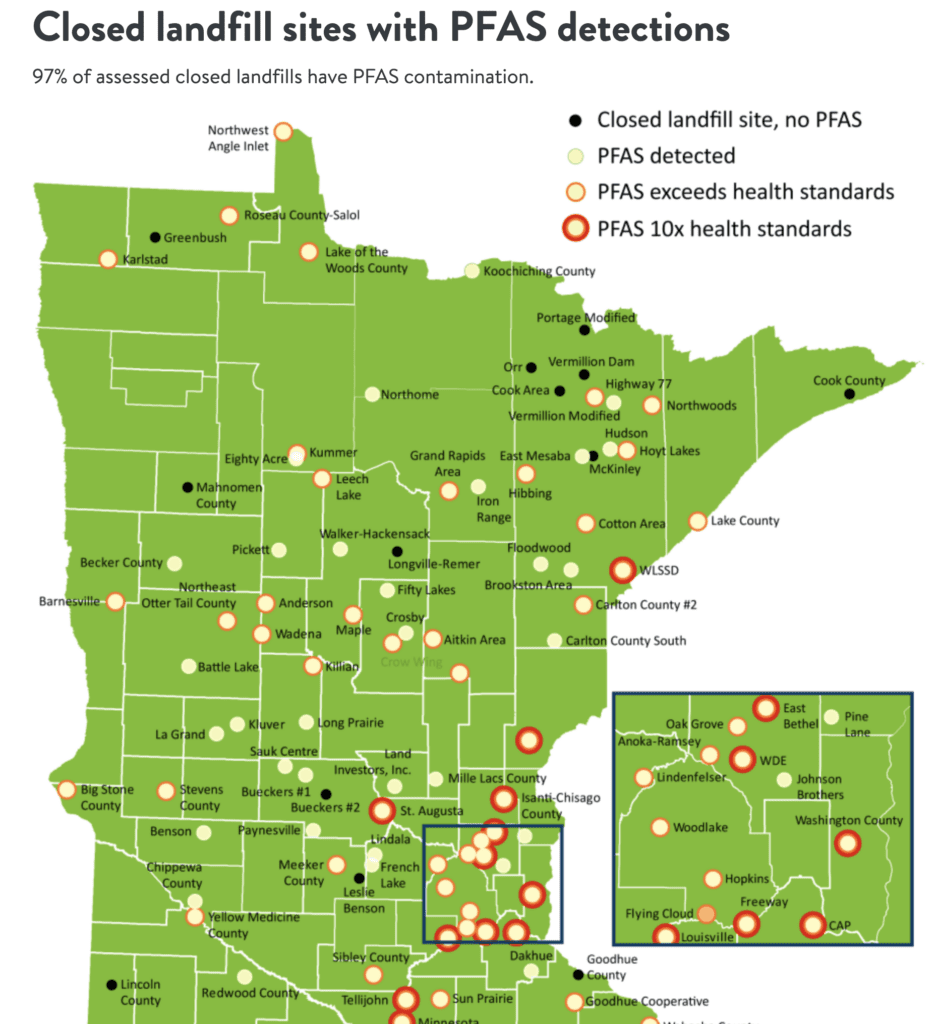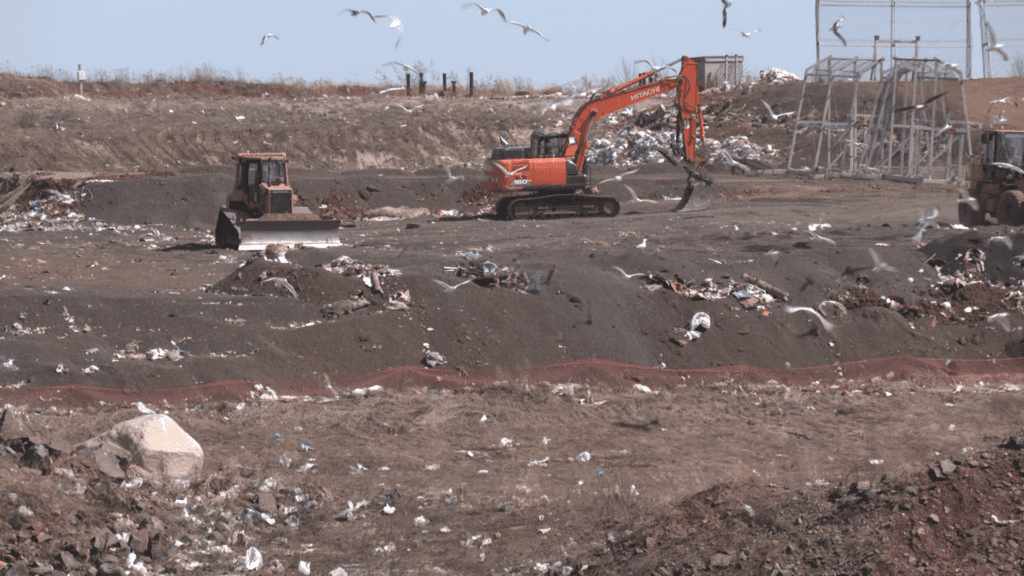Protecting Lake Superior from PFAS from landfill leachate
Smelting is a beloved pastime for many in the Northland, but there’s a threat lurking under the surface of Lake Superior.
Known as ‘forever chemicals’, PFAS are a class of thousands of different compounds that do not break down naturally.
“PFAS is an acronym which stands for per and poly for alkyl substances. The thing they have in common are the carbon fluorine bond and individual compounds vary by chain length and things like that,” said Wisconsin DNR Toxicologist Sean Strom. “They have specific properties that make them useful and certain types of products, you know, firefighting foam, fast food wrappers, water and stain repellent, fabrics, things like that.”
In 2021, the Wisconsin DNR issued its first ever PFAS-based fish consumption advisory for Lake Superior. The advisory was issued after elevated levels of PFAS were found in rainbow smelt near the Apostle Islands and off the shore of Port Wing.
“The current advisory for smelt on Lake Superior is no more than one meal per month,” said Strom. “Eating one meal, it’s not like you’re going to get instantly sick. These are long term complications, but they include everything from it impacts thyroid function to it impacts cholesterol levels to certain types of cancers.”
PFAS were also found in several other fish species including lake trout, herring, and lake whitefish, but the levels were not enough to warrant an advisory at this time.
“Based on other contaminants like PCBs, Lake Superior is so large that it just takes a really, really long time for contaminants to kind of cycle out of the lake ecosystem, and so once they’re there, it’s likely that they’ll be there for a while,” explained Strom.
There are likely multiple sources for PFAS entering Lake Superior. One that has gotten the attention of lawmakers recently is wastewater.
“It is discharged into the St. Louis Bay,” said Western Lake Superior Sanitary District Executive Director Marianne Bohren. “We treat approximately 13.9 billion gallons of wastewater each and every year, and approximately that value is what is discharged at the end of the plant.”
According to the Minnesota Pollution Control Agency, PFAS contamination has been found in groundwater at 59 closed landfills in 41 counties at levels that exceed the Minnesota Department of Health’s health-based guidance values for PFAS. Out of the 101 landfills tested in the MPCA Closed Landfill Program, PFAS contamination in groundwater was found in 98.

At WLSSD, the concentration is just over ten times the health-based guidance value.
“As with many landfills that have been closed for many years, detection of PFAS contamination is resulting in expanding the monitoring work which will lead to a reassessment of what additional cleanup actions may be necessary,” said the MPCA.
As part of the MPCA’s PFAS Monitoring Plan, the Solid Waste Program is currently sampling at a subset of the permitted solid waste facilities for PFAS.
“The basis for the wastewater that flows here at the wastewater treatment facility, we are dealing with the conventional pollutants. so we treat for waste in general,” said Bohren. “The treatment plants themselves were not designed to remove PFAS chemicals.”
St. Louis County Environmental Services Department Director David Fink believes that with more research, PFAS can be controlled.
“The conversation started in about 2017 with our regulator and our engineer that visited. We’re one of the only one of the eight of the 20 landfills in Minnesota that actually land applies. We’re pretty proud of our record for land application and our environmental control because our receiving water is the groundwater,” said Fink. “So we have to protect the groundwater. It was an emerging contaminant of concern that when our regulator said, you know, you’re going to have to change what you do and maybe send it to the nearest wastewater treatment plant. We said, ‘no, we think we can. We have a long track record of controlling and making sure no contaminants enter the groundwater aquifer, and I think we can control this one. We want to research this’.”
Research at the St. Louis county Regional Landfill in Virginia started in a small greenhouse but has since expanded.
“All these controls, including a plastic liner that collects all of the snowmelt and water that circulates through the waste mass and collects it on that line, or gravity feeds down to some clumps along the edge. and then all of that in our case, gets pumped to collection ponds from pumps within the landfill,” Fink explained. “And we have a primary and a secondary pond that we collected in the primary pond, which does some settlement, and there’s not a lot of treatment. That’s why we’re looking at enhanced treatment for all of these parameters to make sure that we’re treating everything.”

This legislative session, the Minnesota House of Representatives will vote on a bill that would further this work, dedicating $4.5 million to the replacement of the landfill’s current leachate treatment system.
“That money would go a long way to control and treat and upgrade the treatment and doing it with some of the renewable energy resources that we’re hoping to project as well,” said Fink.
More information about HF 1152 can be found at this link. St. Louis County Commissioner Keith Nelson is among those in support of the bill.
“This is the greatest of the Great Lakes for us to be discharging leachate into this lake. It’s just not right, and we need to do something about it,” said Nelson. “We’re not waiting for the next generation to deal with it. The St. Louis County Board is wanting to deal with that right now.”
If the bill passes, removing PFAS from wastewater will be a starting point.
“We’re talking about dealing with it on an area wide basis, not just St. Louis County. So we’re seeking the state’s help and funding,” said Nelson. “What is the right thing to do? It’s environmentally the right thing to do. It’s for our kids, our grandkids.”
Fink has already started getting calls from landfills across the nation interested in learning from this research.
“We’ve always been proactive in making sure that we protect the environment and now this is a new emerging contaminant,” said Fink. “A lot of landfills are looking at different technologies. We’re sharing some of the things that we’re finding out with other landfills.”
There is another bill in the house for a $20 million project that involves acquiring property in Canyon and constructing a landfill there with the capability of accepting waste across Northeastern Minnesota and removing PFAS from it.
The Minnesota Department of Health is in the process of testing all community water supplies for PFAS. Duluth, Two Harbors, Beaver Bay, and Grand Marais are among cities that use water from Lake Superior for their community water supply.
So far, the only community water supply that uses Lake Superior and has complete test results is Grand Marais. No PFAS were found in Grand Marais water, and testing is in progress for other communities that use water from the lake.
The MPCA is currently testing more fish from Lake Superior and tributaries for PFAS. Data from these tests is expected to be shared this summer.
More information on the ongoing PFAS testing in Minnesota can be found at this link.